2005 RENAULT MEGANE Brake
[x] Cancel search: BrakePage 105 of 250
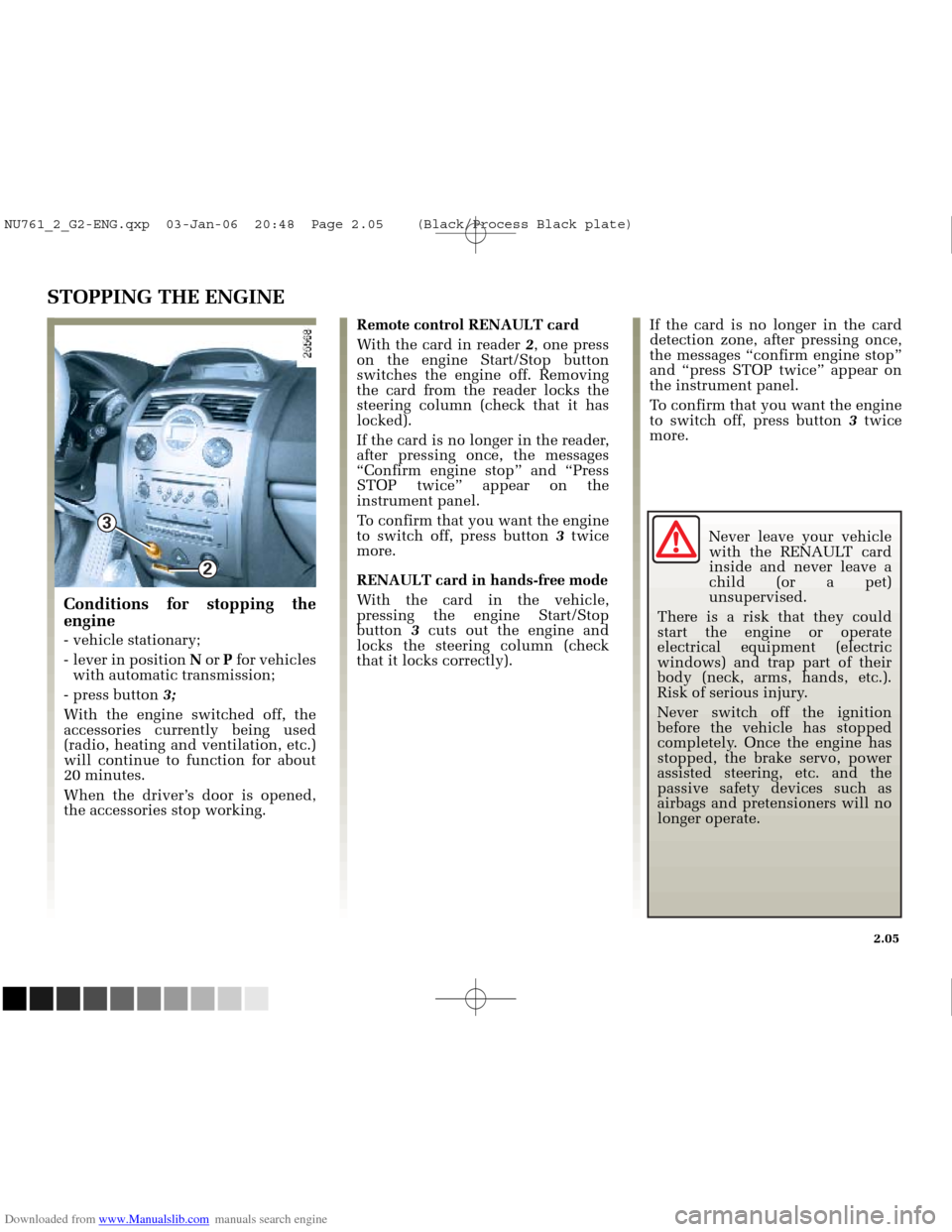
Downloaded from www.Manualslib.com manuals search engine
2
3
NU761_2_G2-FRA.qxd 4/11/05 10:48 Page 2.05
STOPPING THE ENGINE
If the card is no longer in the card
detection zone, after pressing once,
the messages “confirm engine stop”
and “press STOP twice” appear on
the instrument panel.
To confirm that you want the engine
to switch off, press button 3twice
more.
Conditions for stopping the
engine
- vehicle stationary;
- lever in position Nor Pfor vehicles
with automatic transmission;
- press button 3;
With the engine switched off, the
accessories currently being used
(radio, heating and ventilation, etc.)
will continue to function for about
20 minutes.
When the driver’s door is opened,
the accessories stop working. Remote control RENAULT card
With the card in reader
2, one press
on the engine Start/Stop button
switches the engine off. Removing
the card from the reader locks the
steering column (check that it has
locked).
If the card is no longer in the reader,
after pressing once, the messages
“Confirm engine stop” and “Press
STOP twice” appear on the
instrument panel.
To confirm that you want the engine
to switch off, press button 3twice
more.
RENAULT card in hands-free mode
With the card in the vehicle,
pressing the engine Start/Stop
button 3cuts out the engine and
locks the steering column (check
that it locks correctly).
2.05
Never leave your vehicle with the RENAULT card
inside and never leave a
child (or a pet)
unsupervised.
There is a risk that they could
start the engine or operate
electrical equipment (electric
windows) and trap part of their
body (neck, arms, hands, etc.).
Risk of serious injury.
Never switch off the ignition
before the vehicle has stopped
completely. Once the engine has
stopped, the brake servo, power
assisted steering, etc. and the
passive safety devices such as
airbags and pretensioners will no
longer operate.
NU761_2_G2-ENG.qxp 03-Jan-06 20:48 Page 2.05 (Black/Process Black\
plate)
Page 110 of 250
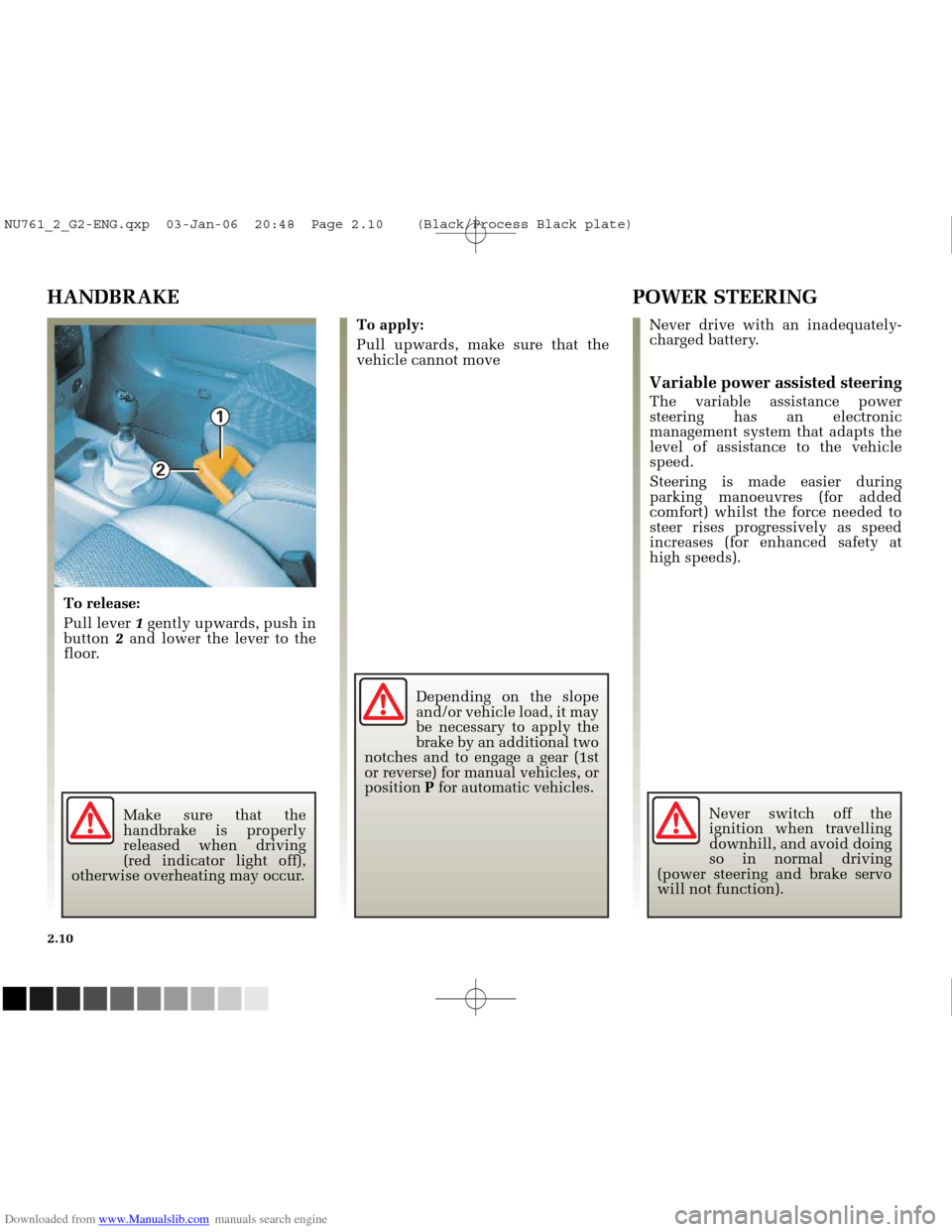
Downloaded from www.Manualslib.com manuals search engine
1
2
NU761_2_G2-FRA.qxd 4/11/05 10:48 Page 2.10
2.10
HANDBRAKE POWER STEERING
Never drive with an inadequately-
charged battery.
Variable power assisted steering
The variable assistance power
steering has an electronic
management system that adapts the
level of assistance to the vehicle
speed.
Steering is made easier during
parking manoeuvres (for added
comfort) whilst the force needed to
steer rises progressively as speed
increases (for enhanced safety at
high speeds).
To apply:
Pull upwards, make sure that the
vehicle cannot move
To release:
Pull lever 1gently upwards, push in
button 2and lower the lever to the
floor.
Make sure that the
handbrake is properly
released when driving
(red indicator light off),
otherwise overheating may occur. Depending on the slope
and/or vehicle load, it may
be necessary to apply the
brake by an additional two
notches and to engage a gear (1st
or reverse) for manual vehicles, or
position Pfor automatic vehicles.
Never switch off the
ignition when travelling
downhill, and avoid doing
so in normal driving
(power steering and brake servo
will not function).
NU761_2_G2-ENG.qxp 03-Jan-06 20:48 Page 2.10 (Black/Process Black\
plate)
Page 119 of 250

Downloaded from www.Manualslib.com manuals search engine
A
NU761_2_G2-FRA.qxd 4/11/05 10:48 Page 2.19
ELECTRONIC STABILITY PROGRAM: ESP WITH UNDERSTEER CONTROL
When the function begins to
operate, warning light Aflashes to
warn you.
If the warning light comes on
accompanied by the “ASR/ESP
deactivated” message when the
engine is started, slowly turn the
steering wheel from lock to lock to
reinitialise the system.
Understeer control
This system optimises the operation
of the ESP in the case of pronounced
understeering (loss of front axle
roadholding).
Operating faults
If the system detects an operating
fault, the message “Check traction
control” or “ESP/ASR not
functioning” is displayed on the
instrument panel display along with
indicator light and indicator
light A.
Contact your RENAULT Dealer.
This system helps to keep control of
the vehicle in critical driving
situations (avoiding an obstacle, loss
of grip when cornering, etc.) and
works in conjunction with the
understeer control system.
Operating principle
A sensor in the steering wheel
detects the direction selected by the
driver.
Other sensors throughout the vehicle
measure the actual direction.
The system compares the direction
selected by the driver and the actual
direction of the vehicle and corrects
this as necessary by applying the
brakes selectively and/or acting on
the engine power.
2.19
This function is an
additional aid in case of
critical driving conditions
to enable the vehicle
behaviour to be adapted to suit
the driving conditions.
However, the function does not
take the place of the driver. It
does not increase the vehicle’s
limits and should not encourage
you to drive more quickly.
Therefore, it can under no
circumstances replace the
vigilance or responsibility of the
driver when manoeuvring the
vehicle (the driver must always
be ready for sudden incidents
which may occur when driving).
NU761_2_G2-ENG.qxp 03-Jan-06 20:48 Page 2.19 (Black/Process Black\
plate)
Page 120 of 250

Downloaded from www.Manualslib.com manuals search engine
A
NU761_2_G2-FRA.qxd 4/11/05 10:48 Page 2.20
2.20
TRACTION CONTROL: ASR
Operating principle
Using the wheel sensors, the system
measures and compares the speed of
the drive wheels at all times and
slows down their over-rotation.
If a wheel is starting to spin, the
system brakes automatically until
the drive supplied becomes
compatible with the level of grip.The system also adjusts the engine
speed to the grip available under the
wheels, independently of the
pressure exerted on the accelerator
pedal.
When the function begins to
operate, warning light
Aflashes to
warn you.
This system helps to limit skidding
on drive wheels and to control the
vehicle when pulling away or
accelerating.
This function is an
additional aid in case of
critical driving conditions
to enable the vehicle
behaviour to be adapted to suit
the driving conditions.
However, the function does not
take the place of the driver. I t
does not increase the vehicle’s
limits and should not encourage
you to drive more quickly.
Therefore, it can under no
circumstances replace the
vigilance or responsibility of the
driver when manoeuvring the
vehicle (the driver must always
be ready for sudden incidents
which may occur when driving).
NU761_2_G2-ENG.qxp 03-Jan-06 20:48 Page 2.20 (Black/Process Black\
plate)
Page 122 of 250
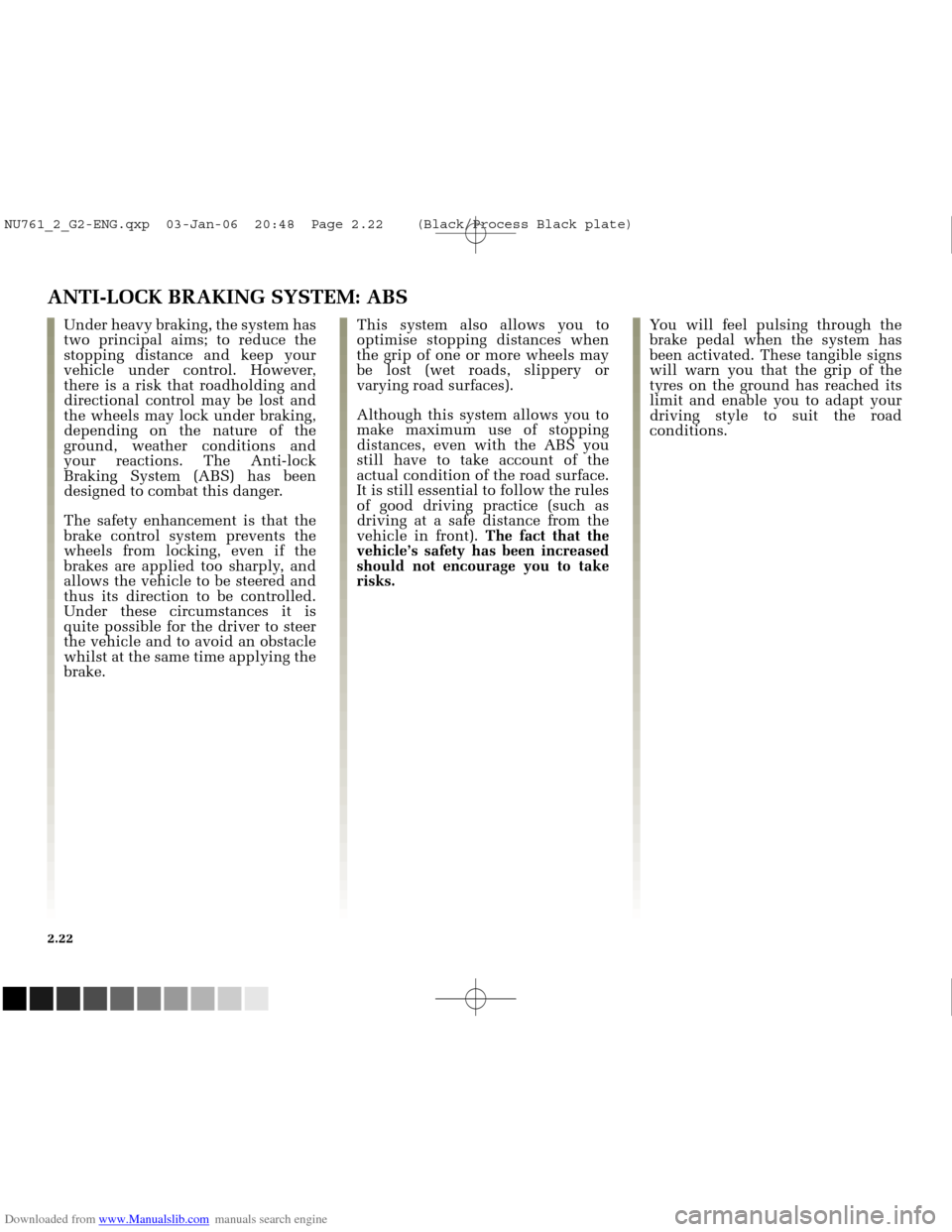
Downloaded from www.Manualslib.com manuals search engine
NU761_2_G2-FRA.qxd 4/11/05 10:48 Page 2.22
2.22
ANTI-LOCK BRAKING SYSTEM: ABS
You will feel pulsing through the
brake pedal when the system has
been activated. These tangible signs
will warn you that the grip of the
tyres on the ground has reached its
limit and enable you to adapt your
driving style to suit the road
conditions.
This system also allows you to
optimise stopping distances when
the grip of one or more wheels may
be lost (wet roads, slippery or
varying road surfaces).
Although this system allows you to
make maximum use of stopping
distances, even with the ABS you
still have to take account of the
actual condition of the road surface.
It is still essential to follow the rules
of good driving practice (such as
driving at a safe distance from the
vehicle in front).
The fact that the
vehicle’s safety has been increased
should not encourage you to take
risks.
Under heavy braking, the system has
two principal aims; to reduce the
stopping distance and keep your
vehicle under control. However,
there is a risk that roadholding and
directional control may be lost and
the wheels may lock under braking,
depending on the nature of the
ground, weather conditions and
your reactions. The Anti-lock
Braking System (ABS) has been
designed to combat this danger.
The safety enhancement is that the
brake control system prevents the
wheels from locking, even if the
brakes are applied too sharply, and
allows the vehicle to be steered and
thus its direction to be controlled.
Under these circumstances it is
quite possible for the driver to steer
the vehicle and to avoid an obstacle
whilst at the same time applying the
brake.
NU761_2_G2-ENG.qxp 03-Jan-06 20:48 Page 2.22 (Black/Process Black\
plate)
Page 123 of 250
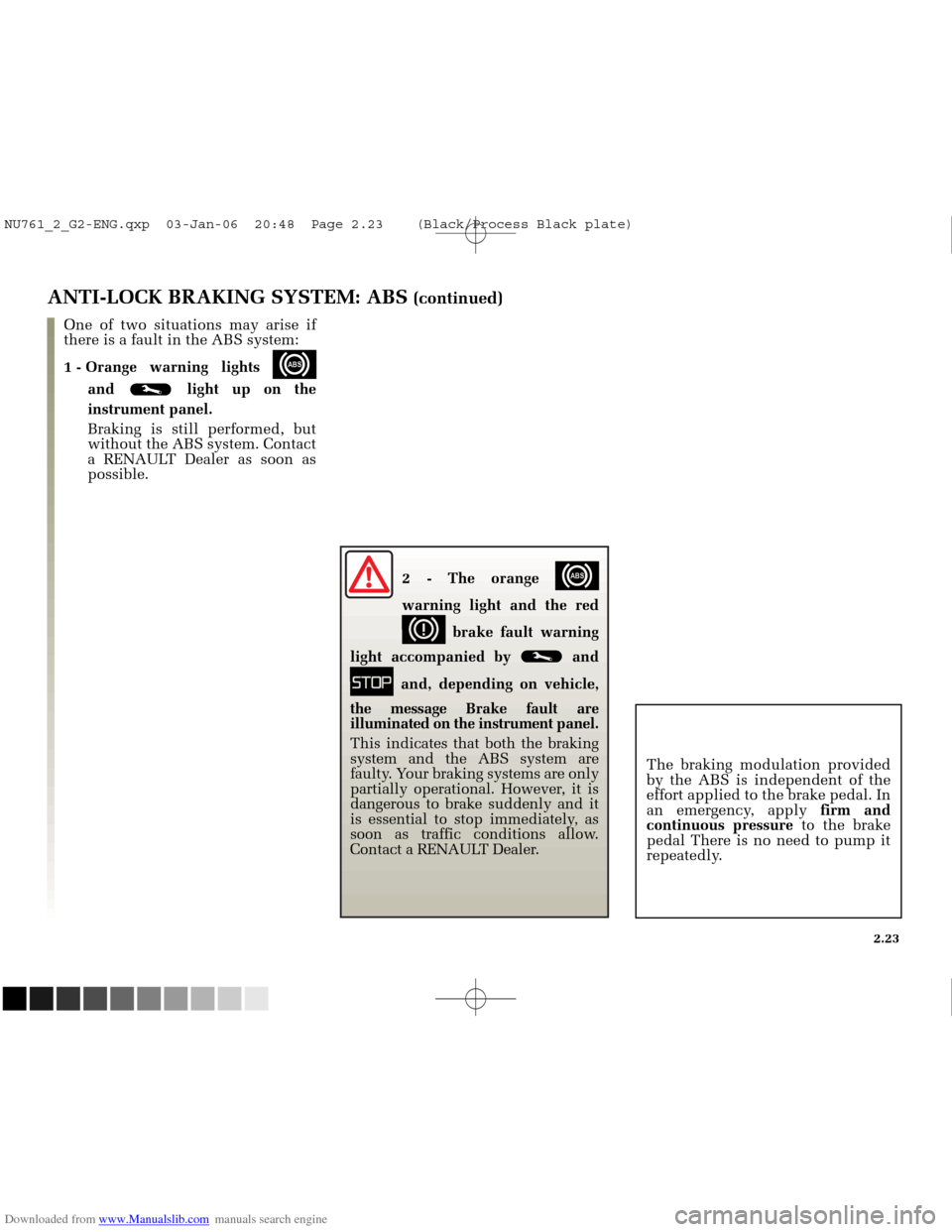
Downloaded from www.Manualslib.com manuals search engine
NU761_2_G2-FRA.qxd 4/11/05 10:48 Page 2.23
ANTI-LOCK BRAKING SYSTEM: ABS (continued)
One of two situations may arise if
there is a fault in the ABS system:
1 - Orange warning lights
x
and light up on the
instrument panel.
Braking is still performed, but
without the ABS system. Contact
a RENAULT Dealer as soon as
possible.
The braking modulation provided
by the ABS is independent of the
effort applied to the brake pedal. In
an emergency, apply firm and
continuous pressure to the brake
pedal There is no need to pump it
repeatedly.
2.23
2 - The orange x
warning light and the red
dbrake fault warning
light accompanied by and
ûand, depending on vehicle,
the message Brake fault are
illuminated on the instrument panel.
This indicates that both the braking
system and the ABS system are
faulty. Your braking systems are only
partially operational. However, it is
dangerous to brake suddenly and it
is essential to stop immediately, as
soon as traffic conditions allow.
Contact a RENAULT Dealer.
NU761_2_G2-ENG.qxp 03-Jan-06 20:48 Page 2.23 (Black/Process Black\
plate)
Page 124 of 250
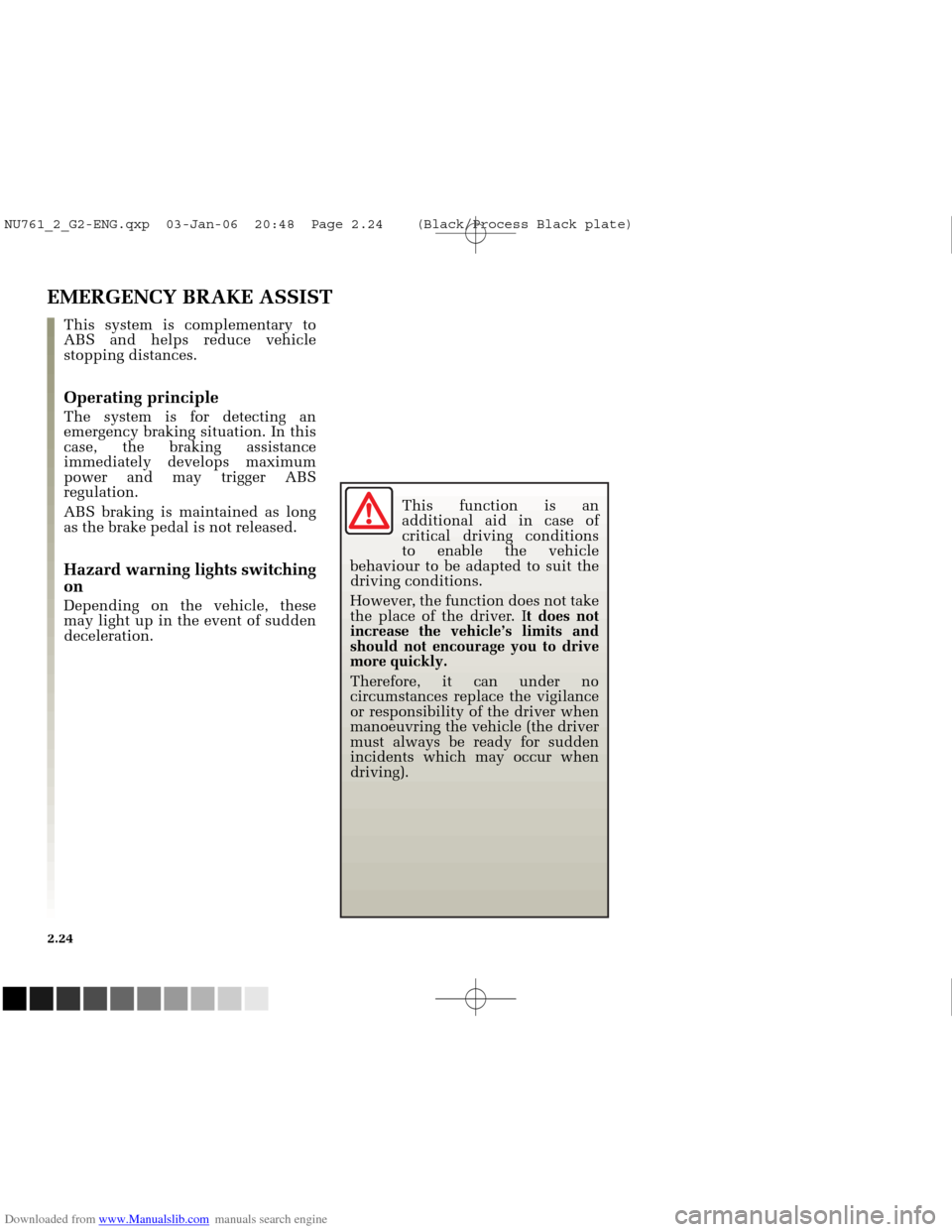
Downloaded from www.Manualslib.com manuals search engine
NU761_2_G2-FRA.qxd 4/11/05 10:48 Page 2.24
2.24
EMERGENCY BRAKE ASSIST
This system is complementary to
ABS and helps reduce vehicle
stopping distances.
Operating principle
The system is for detecting an
emergency braking situation. In this
case, the braking assistance
immediately develops maximum
power and may trigger ABS
regulation.
ABS braking is maintained as long
as the brake pedal is not released.
Hazard warning lights switching
on
Depending on the vehicle, these
may light up in the event of sudden
deceleration.This function is an
additional aid in case of
critical driving conditions
to enable the vehicle
behaviour to be adapted to suit the
driving conditions.
However, the function does not take
the place of the driver. I t does not
increase the vehicle’s limits and
should not encourage you to drive
more quickly.
Therefore, it can under no
circumstances replace the vigilance
or responsibility of the driver when
manoeuvring the vehicle (the driver
must always be ready for sudden
incidents which may occur when
driving).
NU761_2_G2-ENG.qxp 03-Jan-06 20:48 Page 2.24 (Black/Process Black\
plate)
Page 128 of 250
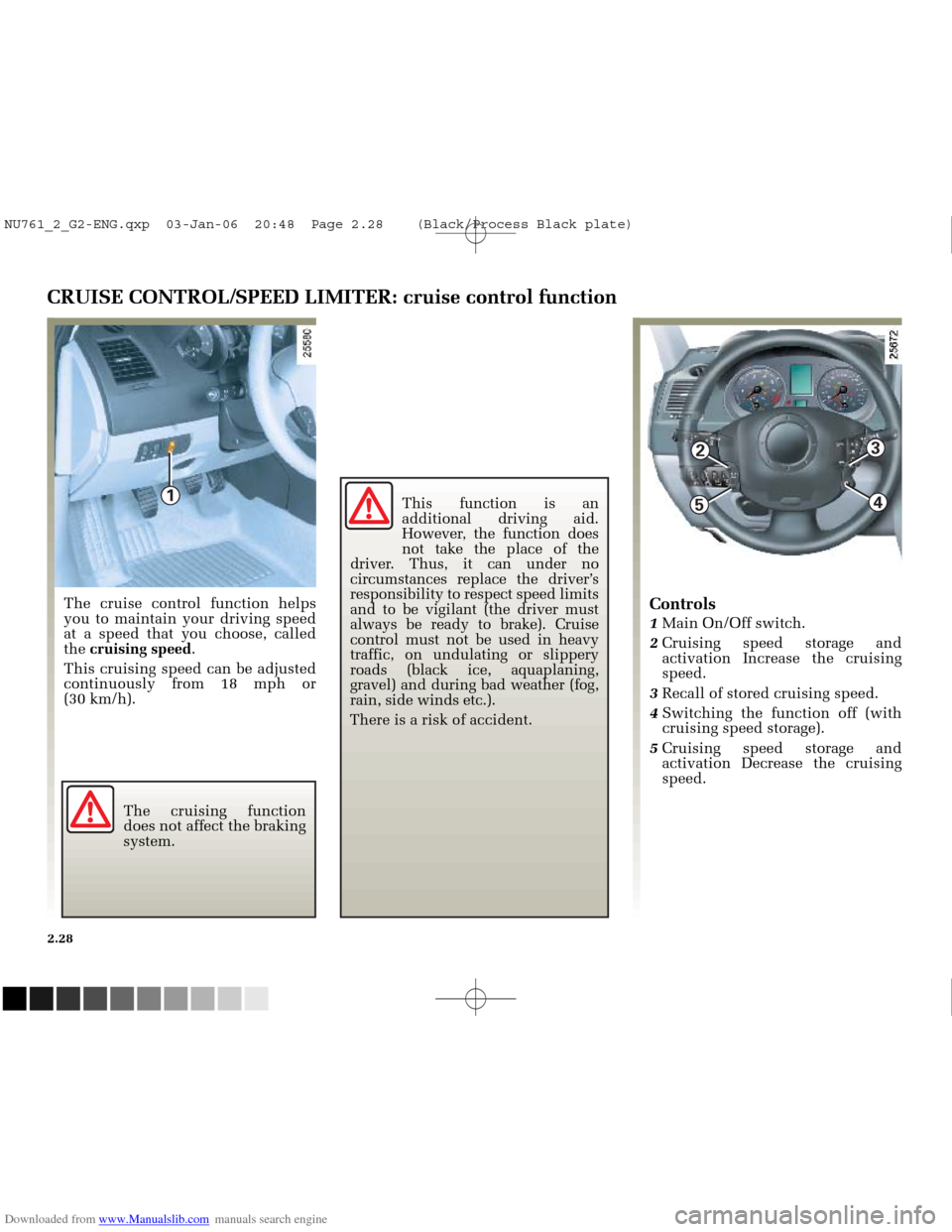
Downloaded from www.Manualslib.com manuals search engine
1
2
5
3
4
NU761_2_G2-FRA.qxd 4/11/05 10:48 Page 2.28
2.28
CRUISE CONTROL/SPEED LIMITER: cruise control function
The cruise control function helps
you to maintain your driving speed
at a speed that you choose, called
the cruising speed .
This cruising speed can be adjusted
continuously from 18 mph or
(30 km/h).Controls
1 Main On/Off switch.
2 Cruising speed storage and
activation Increase the cruising
speed.
3 Recall of stored cruising speed.
4 Switching the function off (with
cruising speed storage).
5 Cruising speed storage and
activation Decrease the cruising
speed.
The cruising function
does not affect the braking
system. This function is an
additional driving aid.
However, the function does
not take the place of the
driver. Thus, it can under no
circumstances replace the driver’s
responsibility to respect speed limits
and to be vigilant (the driver must
always be ready to brake). Cruise
control must not be used in heavy
traffic, on undulating or slippery
roads (black ice, aquaplaning,
gravel) and during bad weather (fog,
rain, side winds etc.).
There is a risk of accident.
NU761_2_G2-ENG.qxp 03-Jan-06 20:48 Page 2.28 (Black/Process Black\
plate)